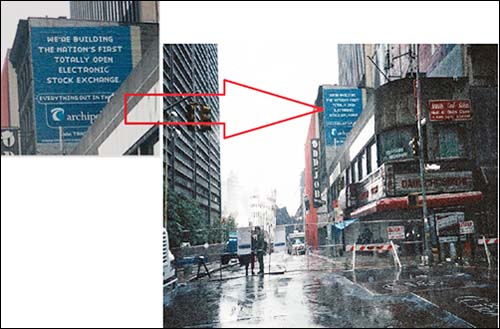(WMR)—WMR has learned from survivors of the 9/11 attack that the recent opening of the 104-story One World Trade Center in New York completes a project long sought by Wall Street tycoons to lay-off New York Stock Exchange traders and create an electronic stock exchange. It was not merely the asbestos problem that plagued the former World Trade Center buildings, brought down on September 11, 2001, but the need to replace the antiquated New York Stock Exchange trading floor with the Archipelago Exchange or NYSE Arca, which links the NYSE’s electronic exchange via a high-speed optical fiber link to Chicago.
Plans were already underway to terminate a number of traders on the NYSE floor when two passenger aircraft struck the North and South Towers of the World Trade Center on 9/11. Had the planes not destroyed the towers, a number of employees of securities firms located in the buildings and who died in the attacks would have soon found themselves without jobs as the Archipelago Exchange made their positions redundant. Today, the Archipelago is headquartered in 7 World Trade Center, which replaces the previous Building 7 that collapsed in the late afternoon of September 11 after Larry Silverstein, the man who leased the World Trade Center complex from the Port Authority of New York and New Jersey, was recorded as ordering the structure “pulled.” “Pull” is a term commonly used for controlled demolitions.
WMR has obtained a photograph [below] showing that plans were already underway for the Archipelago e-exchange when 9/11 occurred. The photo was taken on the morning of September 12, 2001, the day after the trade center’s destruction. A sign proudly heralding the transformation of “the Street” to the “nation’s first totally open electronic stock exchange” is seen with the ruins of the Twin Towers in the background. The dirty little secret about 9/11 is that many of those securities employees who lost their lives that day would have soon lost their jobs as a result of Archipelago. That fact is not explained in the kitschy 9/11 museum at Ground Zero.
Chairman and CEO of the New York Stock Exchange Dick Grasso was reportedly opposed to the Archipelago plans. In 2004, New York Attorney General Eliot Spitzer brought a lawsuit against Grasso in which Spitzer demanded the executive forfeit most of his $140 million deferred salary package. In 2008, the New York state Appeals Court dismissed all claims against Grasso and then-Attorney General Andrew Cuomo dropped the matter completely. WMR is told the reason why the state dropped its suit against Grasso is that the man who went from a clerk to head up the world’s largest stock exchange knows all about Silverstein and his cronies’ operations to streamline the business activities of “The Street,” which includes knowing quite literally “where the bodies are buried.”
Previously published in the Wayne Madsen Report.
Copyright © 2014 WayneMadenReport.com
Wayne Madsen is a Washington, DC-based investigative journalist and nationally-distributed columnist. He is the editor and publisher of the Wayne Madsen Report (subscription required).




The building’s collapse coinciding with the attacks on the twin towers does seem to suggest that the collapse of those towers was used as convenient cover and may even imply prior knowledge of the attack. It fell at free fall speed, symmetrically, into its own footprint, seemingly without having sustained any substantial damage. A classic example of controlled demolition.
If the building was “pulled” (i.e. deliberately demolished) to make way for this, and especially if people died, were injured, or were defrauded as a result, then justice demands that the perpetrators be properly punished and victim’s families duly compensated.